About this blog: We had seen it on the lavender coloured 100 rupees Indian currency. Rani ki Vav, located at Patan in Gujarat is truly the Queen of stepwells, not only because of its grandeur in architecture and construction, but also for the vision. We had recently visited Gujarat for a week-long trip and made a short trip to Rani Ki Vav. Read this blog to know more about this grand stepwell of India, its history, architecture and other useful information for a visit to Rani ki Vav.
A flight of steps leads to a beautifully carved multistoried pavilion that finally leads to a water reservoir. From a distance, the stepwell might not look much. But once you go closer, you will simply be overwhelmed by the sheer exquisiteness of the structure. Rani ki Vav is truly the Queen of Stepwells.

There are these huge architectural gems built like inverted fortresses deep inside the earth found mostly in western and northern India. They were the answer to the shortage of water in those arid regions. These structures or stepwells, also known as Baoli, baori or vav can be found in many places in Gujarat, Rajasthan, northern India and any places that have water shortage due to climatic and geographic conditions.
Some of these stepwells can be traced back to the Indus Valley Civilization. In short, these stepwells were dug deep into the earth to provide a constant supply of water all through the year. The steps were there to ensure easy collection of water. The earliest stepwells were simple in construction and design. With time, the architecture and construction of these stepwells became more intricate and complex. Almost 2000 stepwells can still be found in India and Rani ki Vav in Gujarat is one of the most beautiful ones among them.
Rani ki Vav – the Queen of Stepwells
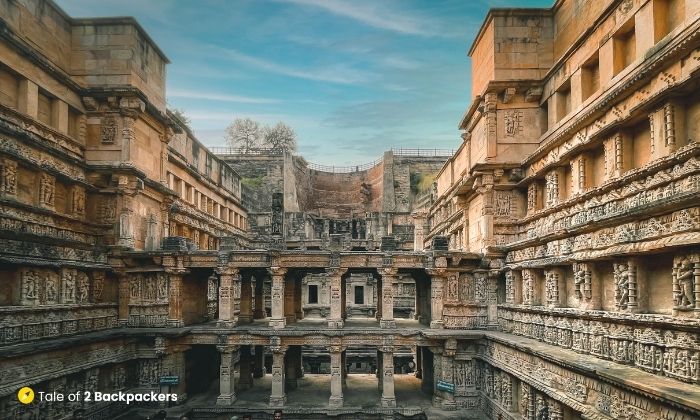
Situated on the banks of Saraswati River in the town of Patan, Rani ki Vav stands as one of the finest architectural gems of the Solanki dynasty. Also known as Rani-ni-Vav, this stepwell has been immortalized on the one hundred rupees note of Indian currency.
The architecture and grandeur of this stepwell makes Rani ki Vav the Queen of stepwells both literally and figuratively. Rani ki Vav is the only stepwell in India that has been declared as an UNESCO World Heritage Site.
Rani ki Vav – History
The Queen of Stepwells was commissioned by a queen herself. Queen Udaymati of Solanki (Chalukya) dynasty had built this stepwell in memory of her late husband King Bhimadeva I. And of course, the stepwell was also built for utilitarian purposes, for the well being of her subjects.
The Solanki Kings ruled over regions in present day Gujarat and Rajasthan from 940 CE to 1244 CE. Their capital was located in the ancient city of Anahillavada or Anahillapura, which is the present day Patan in Gujarat. Quite naturally, Patan and the area around was the site of many historic structures including temples, forts and stepwells.

King Bhima I was known for the construction of Modhera Sun Temple and had rebuilt the Somnath Temple. Dilwara Temple in Mount Abu was also built during his tenure.
Rani ki Vav was built during the third quarter of the 11th century by Queen Udaymati the stepwell is among the largest in Gujarat and undoubtedly one of the most beautiful ones in terms of sculpture and design.
Rani ki Vav was created near the banks of River Saraswati. With time, the stepwell had suffered extensive damage due to flooding of River Saraswati. The upper parts of the structure were covered by heavy deposits of sands. With time, Saraswati River changed its course, but the Rani ki Vav faced further neglect.
YOU MAY ALSO LIKE : BRIHADEESWARA TEMPLE, A TESTIMONY TO THE MIGHT OF THE CHOLA KINGS
In the early 19th century, entire pillars and part of the upper stories of the pavilion had collapsed. The components that were not buried under sand were carried off by the owner of the land during that time and was used in the construction of another stepwell in Patan itself.
Rani ki Vav underwent neglect for a long time. Although the existence of this grand structure was known, it did not receive much attention. Finally in 1980, the Archaeological Survey of India (ASI) excavated the area and carried out desilting of the monument and extensive restoration work.
Originally, Rani ki Vav had seven storeys or terraces. Today, only five survive, but that too, through meticulous restoration work by the ASI.

Art and Architecture of Rani ki Vav
Rani ki Vav was one of the most ambitiously built stepwells of its time and is the testimonial of the resourcefulness and the skill of its builders. It has been constructed in the Maru-Gurjara architectural style illustrating the artistic and technological height of step well construction. The structure has been decorated with various religious, mythological as well as secular reliefs and designs that shows the skill and craftsmanship of the artists.
Rani ni Vav measures about 65 metres in length from East to West and 20 metres wide from North to South.
The most significant aspect of the Rani ni Vav is that the stepwell has been built in the design of an inverted temple. Water is sacred in those arid regions and thus it is considered to be the principal deity in this inverted temple.
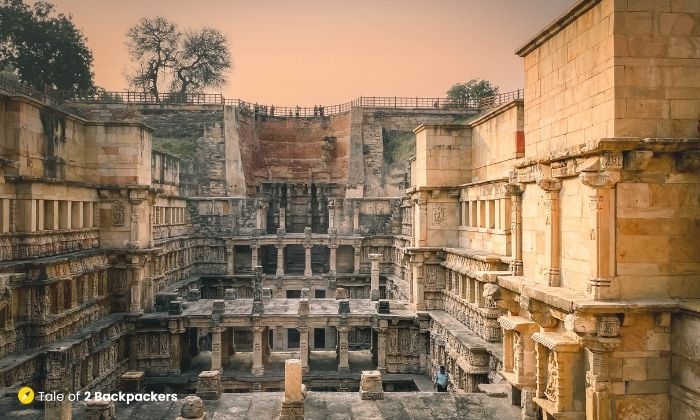
As I mentioned before, there are seven pavilions, the seventh layer being the core of the inverted temple. There were 292 pillars in the pavilions, out of which only 226 remain today. Out of the 226, some are fully intact, while many are partially so. The first two stages of the pavilion are badly damaged, but you can see the architectural details of the stepwell from the third stage onwards. They are quite well preserved and you can see the carvings and sculptures of apsaras and deities in the niches.
YOU MAY ALSO LIKE: ENCHANTING HAMPI – A COMPLETE TRAVEL GUIDE
There are about 500 primary deities adorning the various walls of the stepwell and around 1000 subsidiary ones. In terms of size, Rani ki Vav is definitely massive and the sculptures and designs on the pillars, walls and niches are simply grand. Once you see them, you can only admire the grace and expressiveness etched on the stones.

As these stepwells are subterranean structures, their construction was not that easy compared to that of temples and other monuments. The builders were required to dig a trench and then construct underground staircases to the bottom of the well. Then they were required to build strong embankments to protect the sides.
Rani ki Vav faces the east and the subterranean structure goes down to almost 30 metres underground. This stepwell possesses all the four principal components of a fully developed stepwell of its type. It includes a stepped corridor beginning at the ground level and leading to an underground reservoir (kunda), four pillared pavilions, a draw well at the rear end and a large reservoir to collect the well’s surplus water.
At the ground level, at the head of the monument, there used to be a torana or ceremonial archway. The torana did not pass the vestiges of time and is no longer found.

The masonry tank or kunda that is attached to the well to receive the surplus water through the fourth pavilion was planned befitting the size and grandeur of the monument. The tank measures about 7 metres east to west and 6 metres north to south. The depth of the Kunda is a little less than 3 metres from the third pavilion.
The Well
The draw well situated at the western side of the stepwell is of course the main part of the entire structure. The well has a depth of 28 metres and a diameter of 10 metres at the topmost part. The inner circumference of the stepwell is filled with various sculptures.
Rani ki Vav, like the other stepwells of the region, was fed by river water – River Saraswati in this case.
Sculptures at Rani ki Vav
The sculptures are one of the most striking parts of the stepwell. There are some large sculptures and countless smaller ones decorating the corridors and the well. Each of the terraces had various sculptures of deities and mythological characters.
There were mainly two types of sculptures – various deities and the apsaras. The regent of directions, that is, the dikpalas were also found in many of the sculptures.
The images of Vishnu were found in large numbers. Lord Vishnu is associated with cosmic waters in Hindu mythology. Thus, sculptures of Lord Vishnu in a reclining position on Sheshnag are found in the stepwell.
The avataras of Vishnu
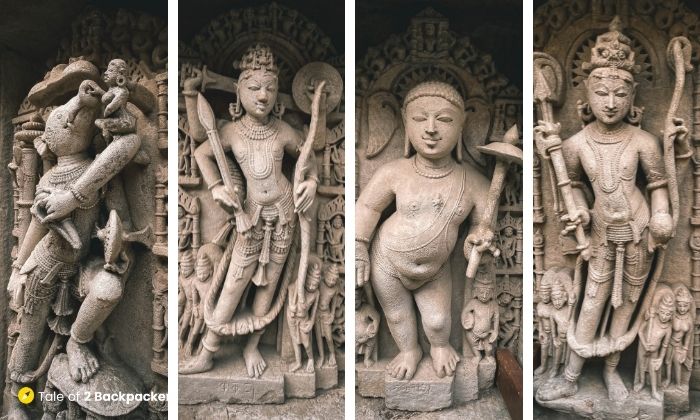
Varaha, Rama, Vamana & Parasuram
There are intricate sculptures of the avataras or incarnations of Lord Vishnu. If you keep an eye, you will easily find the avataras of Varaha or Boar, Vamana or dwarf, Rama, Balarama, Parasurama, Buddha and Kalki. The niche for Narasimha avatar is empty. Perhaps it was there once upon a time. Images of Matsya (Fish) and Kurma (Tortoise) are not found as these incarnations were not represented during this period in Gujarat.
Sculpture of Goddess Durga as Mahisasuramardini
Goddess Durga is depicted as her Mahisasura Mardini form where she has 10 hands and is slaying the demon Mahisasura. The Goddess strikes an aggressive pose wielding her trident. The demon Mahisasura lies at her feet in the form of a supine buffalo with his tongue hanging out. The human form of the demon is seen wielding a sword and shield, but the Goddess is holding on to his hair by her hand.

The Devi on her 10 hands wield various other weapons like thunderbolt, arrow, mace, goad, spear, discus, lotus, kettledrum and sword.
This is definitely one of the most striking sculptures that you will see in Rani ki Vav. It seems as if the entire scene of the fight between Goddess Durga and the demon has come alive through the stones.
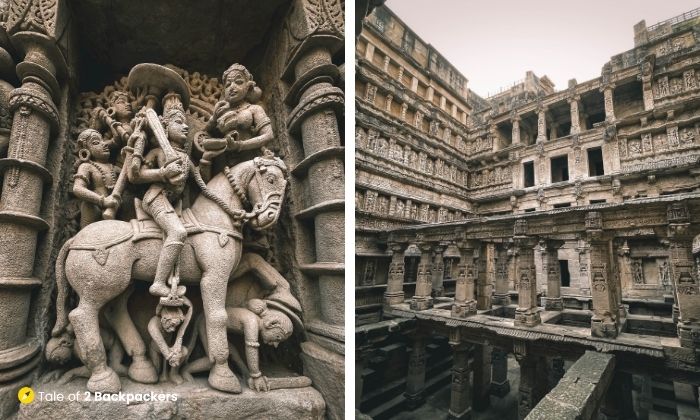
Bhairava
One of the niches has a sculpture of a 20-armed Bhairava. He is holding the tail of a cobra in his right hand and his other hands have various weapons like a thunderbolt, kettledrum, baton, a skull cap and others.
Sculptures of various Gods with their consorts
These are some other interesting sculptures found in Rani ki Vav. You will find the sculptures of various Gods along with their consort like Brahma with Saraswati, Vishnu with Lakshmi and Shiva with Parvati.
Ganesha and Kubara have also been depicted with their consorts.
Sculpture of Vishnu on Sheshnag
For me, the most interesting sculpture was that of Lord Vishnu sleeping on the mythical Sesnag, accompanied by his consort and other figures. And this sculpture is not easily seen. This is found in the central niches of the rear side of the well. I heard that this sculpture was visible depending on the level of water in the well.
Patola designs in Rani ki Vav
Patan is also known for the famous Patola handlooms. I have always believed that temples and monuments depict the then conditions of society. This can be very well seen in the various patola designs carved on the niches of the pavilion. These geometric designs are simple, yet elegant and I could well imagine how graceful they would look on the patola sarees!

There are many other beautiful sculptures in the stepwell and I feel it would take at least an entire day if I had to only look at them carefully. Maybe next time when I visit Gujarat, I will make it a point to spend more time at Patan.

Rani ki Vav is now surrounded by a lush green garden. The entry gate leads to a sprawling green garden which is actually quite soothing to the eyes. A path there leads to the entrance of the stepwell and from there you simply get enthralled by history and the past.
YOU MAY ALSO LIKE: RANN UTSAV – WHEN, WHERE & HOW – A COMPLETE GUIDE
Patola Weaving Centre


If you have time, you can also visit the Patola Weaving Centre located just a few minutes walking distance from rani ki Vav. You can see how the handloom is made, talk to the artisans and can even buy Patola handlooms at a reasonable rate.
Rani ki Vav Guide
How to reach Rani ki Vav, Patan?
Rani ki Vav is located in Patan, which is about 130 km from Ahmedabad. It is about 54 km from Mehsana.
By Air
The nearest airport is the Sardar Vallabhbhai International Airport in Ahmedabad. You can fly into Ahmedabad and then travel to Patan by road. Cars are easily available from Ahmedabad to Patan.
You can also take a bus operated by Gujarat State Road Transport Corporation (GSRTC) from Ahmedabad or any other major cities in Gujarat.
Usually, a day trip to Modhera and Patan is done together from Ahmedabad. We were returning from Little Rann of Kutch to Ahmedabad and visited Modhera and Patan on the way.
By Train
If you are travelling by train, the nearest railway station to Rani ki Vav in Patan is Mehsana junction. You will get trains from Ahmedabad to Mehsana and from there, you can take a car to Patan. The distance is 55 km.
By Road
Patan is well connected by road from all the major cities of Gujarat. So you can travel to Patan easily by road from any part of Gujarat.

Where to stay in Patan?
There are a few hotels and stay options at Patan as well as Mehsana. You can also stay at Ahmedabad or Gandhinagar and make a day trip to Rani ki Vav.
What is the best time to visit?
The best time to visit Rani ki Vav, as well as Gujarat, is during the winter months between October to March.
Visit the stepwell either during the early hours or in the late afternoon. This is also the best time for photographers. We had visited during mid-day and literally got fried in the sun, even though it was the month of December.
Rani ki Vav Entry Fee
Rani ki Vav has a nominal entry fee of INR 40 for Indians and SAARC citizens. Tickets for foreign visitors cost INR 600.
You can get the entry tickets from the ticket office near the entry gate.
There are toilets available, hopefully clean (since I did not use them, I do not know). Dustbins are also placed at strategic positions for the trash.
Rani ki Vav Opening Hours
Rani ki Vav remains open everyday between 8 AM to 6 PM. You will need atleast 2 – 3 hours to visit Rani ki Vav.

Some Interesting facts about Rani ki Vav
- Rani ki Vav is featured in the lavender coloured 100 Rupees Indian currency notes.
- This is perhaps one of the rare occurrences where a Queen built a memorial in tribute to her King.
- Rani ki Vav in Patan is the only stepwell in India to be declared as a World Heritage Site.
- The stepwell measures approximately 65 metres (213 ft) long and 20 metres (66 ft) wide. It has seven levels of stars that lead down to a well.
- There are about 1500 sculptures, big and small, decorating the stepwell.
- The famous patola designs are carved at the walls of the stepwell.
- It is believed that beneath the last step of the stepwell, there is a gate leading to a hidden tunnel. This tunnel goes all the way to Sidhpur, a town close to Patan.
- It is also believed that long back the water of the well had medicinal value and used to cure fever and other minor ailments.
- Not all portions of the stepwell are accessible to visitors.
- At Patan, you can also visit the Jain temples and the Sahasralinga Talav.

As I left Rani ki Vav, I kept thinking of Queen Udaymati, who had the vision of building this grand stepwell. She ensured that people remembered her king through this stepwell that would also help her subjects. Quite a visionary!
Did you like the post about Rani ki Vav? Have you visited the place? Or are you planning to visit there? Please share your thoughts on the stepwell or any other topic in the comments below. We would be happy to hear from you.
If you liked the post, please share this with your family, friends and neighbours.
Pin it for a later Read!
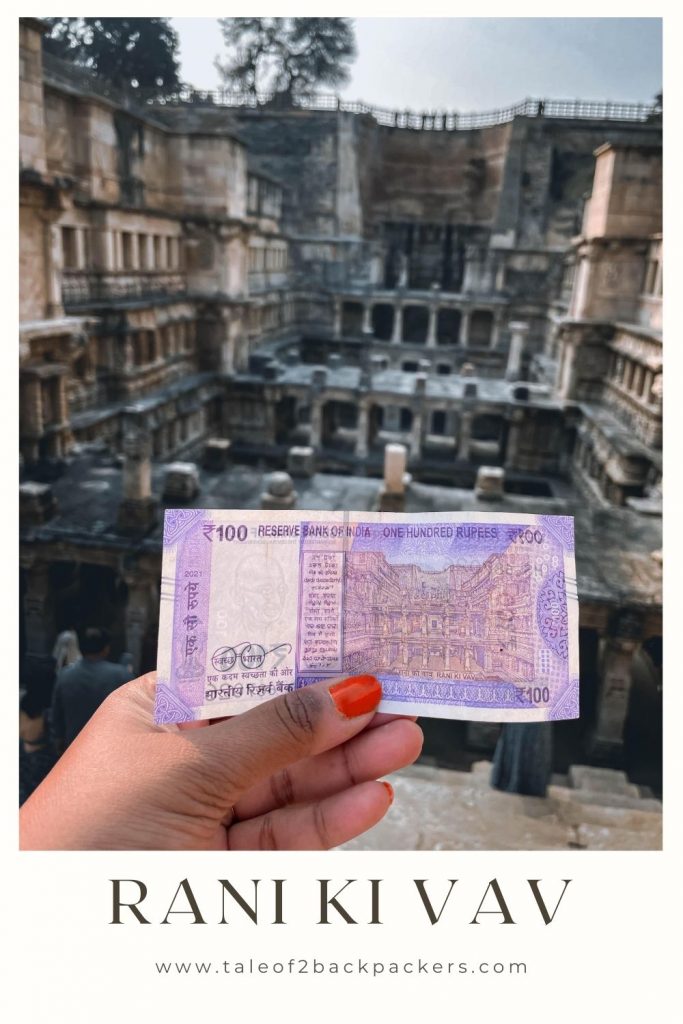



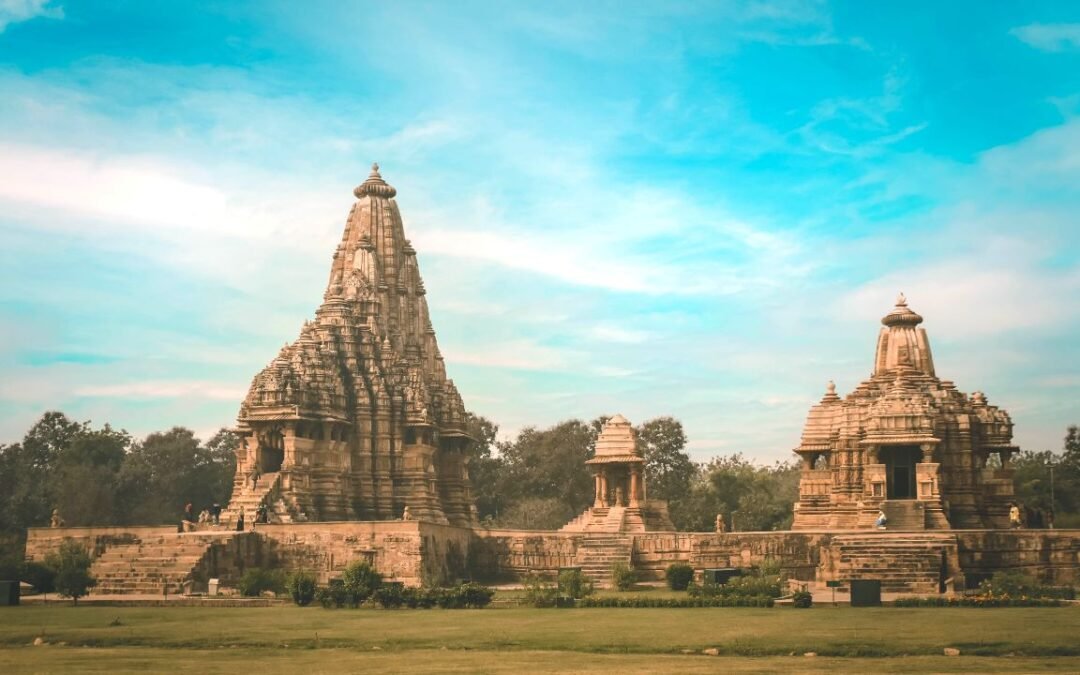






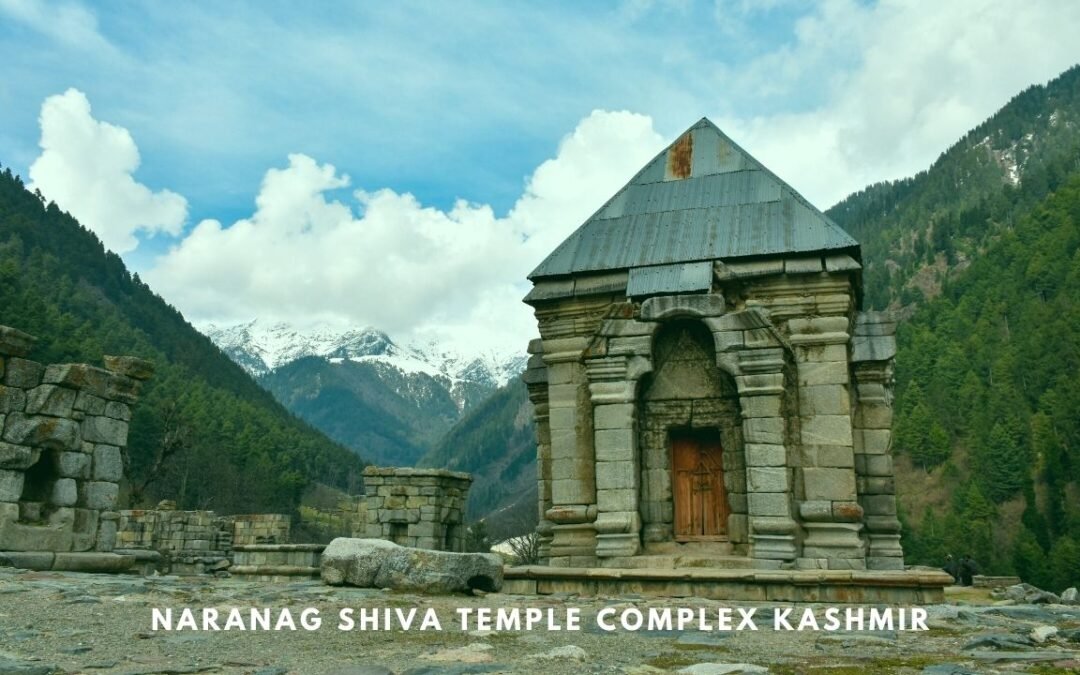
so many unknown treasures are scattered in our country, a very few known to us. nicely described rani ki vav which i was not aware at all. visited the places through your eyes. hope more to come.
Thank you so much Arup! Your comment made our day!